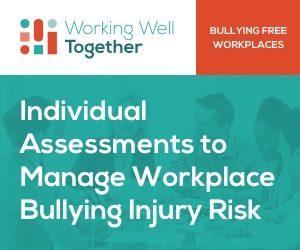For just under two decades, I worked in the community services sector that has managed risk through the completion of individualised assessments. We completed those assessments to understand the client, respond to his or her needs, identify hazards and manage risk.
Workplace bullying comes with significant risk of psychosocial injury to targeted employees. The psychological impact often leads to physical symptoms. In worst case scenarios, an individual may take his or her own life. Using an individualised assessment approach, we can identify hazards and manage risk to employees targeted by workplace bullying. While we can use this as a reactive approach, we can also use it proactively, to eliminate or minimise harm.
Why should you complete an individualised assessment?
Workplace bullying can be challenging to manage because the causes and effects can be unique to an individual. Therefore, our response needs to be tailored to the individual to ensure the best outcome for the target and your organisation or business. Fundamentally, we do this already with a physical injury. If an employee has broken his or her arm, we don’t put a band-aid on it; we assess what we need to do and act. We send that person to a doctor where they get an x-ray. This concept is no different from managing a physical injury.
In managing psychosocial hazards and risk to workplace bullying targets, an individualised assessment:
- allows us to identify and understand what is happening to that individual at a particular point in time and how it got that way;
- allows the development of interventions to minimise the risk of injury, or further injury, to a target of bullying;
- determines measurements to assess progress and effectiveness of interventions; and
- defines the on-going communication relationship between the organisation and the employee.
What does an assessment involve?
The best way to understand what is happening to an injured, or potentially injured, person is to ask them. An individualised assessment is a structured interview. We know that workplace bullying can have significant physical health impacts. Therefore, we ask them what is happening physically. Are they not eating or sleeping; are they suffering from minor infections (eg. colds) more often; are they suffering from headaches or muscular pain more often. We also know that workplace bullying can lead to psychological health issues, so we need to ask them are they tearful, burnt out, anxious or are they thinking about suicide. Are they withdrawing from social interaction with work colleagues or family?
During an individualised assessment, you may observe behaviours. Every time that an employee talks to you, they are tearful or anxious. Their behaviours have become scattered and frenetic. These all form parts of the discussion to help you understand what is happening to them.
To further understand the risk, you need to ask what actions they have taken. Have they been to see a doctor or psychologist? Have they tried anything to resolve or reduce the behaviour from the other person? Did this work?
Develop a plan
Once you have collected the information, you can then develop and implement a plan. It is vital that the plan is developed in conjunction with the person who is injured or at risk. The chances of failure increases if we exclude the target. This may include him or her attending a qualified medical professional. It may include modifying working conditions to keep him or her safe.
In making the plan, it is important set review dates. The greater the impact, the more regularly you will need to check in with the target. Negotiate with him or her as to how the communication should occur. It might be fine to check in via phone on some occasions, but you will want to combine these with face to face catch ups. These allow you to pick up on visual cues that can be hidden when a person is on the other end of a phone or email. Ask whether the strategies that have been put in place are working. If yes, great. If not, how can you adjust and modify the plan to make it more effective?
Document it!
No matter how much we hate it, documenting is a vital part of our modern existence! This process needs to be documented.
In documenting a situation like this, make this part of you standard process that is outlined in your policies and procedure. This means everyone knows what they can expect should you be concerned about their health and safety. Clearly state your reasons for the process (for example because you want to keep people safe and well at work). Ensure that you outline who has access to the documented information and why. If a person is talking about self harm or taking their own life, identify the actions you will take to keep the person safe and manage the risk.
Importantly, share the information you have documented with the targeted person. If you have developed forms for this purpose, provide them with copies of any completed forms. Have both of you sign the forms. This helps create trust between the person and the organisation; that you have nothing to hide. It helps facilitate further open and honest communication. It is a journey that you are taking together via mutual understanding and agreement with the ultimate goal of ensuring that person’s health and safety.
I am not a counsellor…I can’t do the assessment!
One of the first thoughts that might spring to your mind is that completing an assessment requires an appropriately qualified professional. This process is not seeking to replace a professional. The key aim is to eliminate or mitigate hazards and risk. When a community service completes an assessment, it relies on the fact that you will refer to an appropriately qualified professional. This is the case here.
Some organisations and businesses may have an Employee Assistance Program (EAP) that you may suggest should fulfil this role. This can be problematic as many EAPs are set up to only report an unnamed employee accessed the service to the source organisation. If this is the case, how do you as the employer know whether there is a risk with a specific employee, and the risk is eliminated or mitigated? An EAP may be a referral point from your assessment for further appropriately qualified services.
The employee in your organisation who completes an assessment should be one who is designated to do so. He or she should be friendly, empathetic and supportive, with good communication and dispute resolution skills. To complete the role effectively, he or she should have an understanding of what are the injury risks of workplace bullying and effective resolution strategies.
The challenges to completing individualised assessment
In being able to effectively assess individualised risk from psychosocial injury, barriers still loom large in a number of workplaces. This includes:
- Not having an understanding of workplace bullying and associated injury. If you don’t know what it is, you can’t assess or address it.
- Bullying as a blame game. We often label targets of bullying as being weak or unable to cope under pressure. If a person does not feel safe, or that they will be judged and blamed, they simply will not come forward.
- Mental health issues remain stigmatised. Employees who feel their workplace is mentally unhealthy just won’t talk about it nor seek support.
- Not having appropriate systems, policies and procedures in place results in ambiguity of what to expect. As humans, we are fundamentally driven by fear based responses and flee from perceived danger. Not knowing what to expect creates anxiety and fear.
Managing risk through individualised assessment is not a new concept. It has formed part of the community services sector workplace for decades. Implementing this in relation to workplace bullying allows us to proactively manage and prevent the risk of psychosocial injury.
Are you interested in learning more about managing and preventing workplace bullying injury?
Click here to find out about our workplace bullying workshop.


